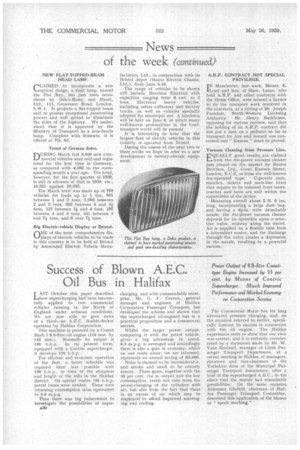Success of Blown AEC.
Page 32

If you've noticed an error in this article please click here to report it so we can fix it.
Oil Bus in Halifax
Power Output of 8.8-litre Comettype Engine Increased by 33 per cent. by Means of Centric Supercharger. Much Improved Performance and Marked Economy on Corporation Service LAST October this paper described how supercharging had been successfully applied to two commercial vehicles running in the North of England under arduous conditions. We are now able to give news of a third—an A.E.C. double-decker operated by Halifax Corporation. This machine is powered by a Comet Mark I 8.8-litre oil engine (115 mm. by 142 mm.). Normally its output is 130 b.h.p. In its present form, equipped with a Centric supercharger, it develops 170 b.h.p. For efficient and economic operation of the fleet, a faster 'schedule was required than was possible with 130 b.h.p., in view of the steepness and length of the hills in the Halifax district. On special routes 155 b.h.p. petrol buses were needed. These were returning consumption rates equivalent to 3.6 m.p.g. Thus there was big inducement to investigate the possibilities of superA30 charging, and with commendable enterprise, Mr. G. F. Craven, general manager and engineer of Halifax Corporation Passenger Transport, has developed the scheme and shown that the supercharged oil-eugined bus is a practical proposition and a commercial success.
Whilst the larger power output, comparing it with the petrol vehicle, gives a big advantage in speed, 6.5 m.p.g. is averaged and accordingly there is also a gain in economy, which on one route alone, we are informed, represents an annual saving of £2,000. Noise is claimed to be inconsiderab:e, and smoke and smell to be entirely absent. These 'gains, together with the 33 per cent. rise in output and the low consumption, result not only from the power-charging of the cylinders with air, but also from the fact that there is an excess of air which may be employed to afford improved scavenging and cooling. The Commercial motor has for long advocated pressure charging, and, on the occasion referred to earlier, specifically forecast its success in connection with the oil engine. The Halifax experiences seem to show that our view was correct, and it is certainly corroborated by a statement made by Mr. W. Vane Morlancl, manager of Leeds Passenger Transport Department, at a recent meeting in Halifax of managers, chairmen and vice-chairmen of the Yorkshire Area of the Municipal Passenger Transport Association, after a trial of the supercharged A.E.C., to the effect that the matter had remarkable possibilities. On the same occasion Alderman Gledhill, chairman of Halifax Passenger Transport Committee, described this application of the blower as "epoch marking."




















































































